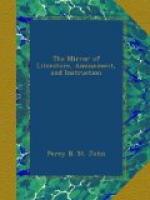Title: The Mirror of Literature, Amusement, and Instruction Volume 10, No. 272, Saturday, September 8, 1827
Author: Various
Release Date: June 12, 2004 [EBook #12595]
Language: English
Character set encoding: ASCII
*** Start of this project gutenberg EBOOK mirror of literature, no. 272 ***
Produced by Jonathan Ingram, David Garcia and the
Online Distributed
Proofreading Team.
THE MIRROR OF LITERATURE, AMUSEMENT, AND INSTRUCTION.
Vol. X, no. 272.] Saturday, September 8, 1827. [Price 2d.
* * * * *
[Illustration: Dublin post office.]
DUBLIN POST OFFICE.
The general post-office, Dublin, was at first held in a small building on the site of the Commercial Buildings, and was afterwards removed to a larger house opposite the bank on College Green (since converted into the Royal Arcade;) and on January 6, 1818, the new post-office in Sackville-street was opened for business.
The foundation-stone of this magnificent building, which is built after a design of Francis Johnson, Esq., was laid by his excellency Charles, Earl of Whitworth, August 12, 1814, and the structure was completed in the short space of three years, for the sum of 50,000l.
The front, which extends 220 feet, has a magnificent portico (80 feet wide), of six fluted Ionic columns, 4 feet 6 inches in diameter. The frieze of the entablature is highly enriched, and in the tympanum of the pediment are the royal arms. On the acroteria of the pediment are three statues by John Smyth, viz.—Mercury on the right, with his Caduceus and purse; On the left Fidelity, with her finger on her lip, and a key in her hand; and in the centre Hibernia, resting on her spear, and holding her shield. The entablature, with the exception of the architrave, is continued along the rest of the front; the frieze, however, is not decorated over the portico. A handsome balustrade surmounts the cornice of the building, which is 50 feet from the ground. With the exception of the portico, which is of Portland stone, the whole is of mountain granite. The elevation has three stories, of which the lower or basement is rusticated, and in this respect it resembles the India House of London, where a rusticated basement is introduced, although the portico occupies the entire height of the structure.
Over the centre of the building is seen a cupola, containing the chimes and bell on which the clock-hammer strikes. The bell is so loud, that it is heard in every part of the city.
The interior is particularly remarkable for the convenience of its arrangement, and the number of its communicating apartments. The board-room is a very handsome apartment, furnished with two seats, which are for the postmasters-general. Over the chimney-piece, protected by a curtain of green silk, is a bust of Earl Whitworth, in white marble, by John Smyth.




